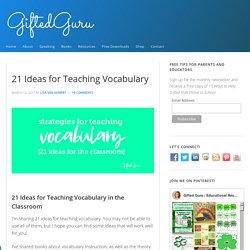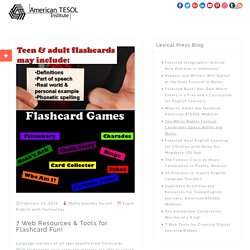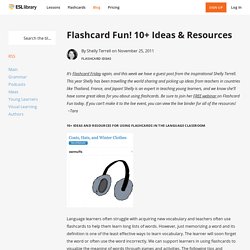

Vocabulary. Visualize Vocabulary: From Remembering to Integration. Dictionaries. 21 Ideas for Teaching Vocabulary in the Classroom. 21 Ideas for Teaching Vocabulary in the Classroom I’m sharing 21 ideas for teaching vocabulary.

You may not be able to use all of them, but I hope you can find some ideas that will work well for you! I’ve shared books about vocabulary instruction, as well as the theory and techniques. This post is a lot more practical. We’re all about ideas today! IDEA #1: Semantic Maps In this activity, the teacher chooses a word and displays it for the class on a whiteboard, etc.. A list is created of all of the words that come to mind, and then those words are categorized. As students read through the text, they can add related words to the map. IDEA #2: Eye Spy Give students a list of words to search for in a text or have them find unfamiliar words.
IDEA #3: Making Choices Students show their understanding of vocabulary by saying the word when it applies, or remaining silent when it doesn’t. 8 Strategies for Teaching ELL Students Vocabulary Words. Strategy 1: Label Objects As a classroom teacher, building leader or district administrator, you should first ensure that the spaces ELL students inhabit most frequently have many object labels.

Whether these are classrooms or cafeterias, having signs that label each physical item in a room forces concrete connections through repeated exposure to the most basic of school concepts that native speakers often take for granted. You can use a template such as this one to create the labels. Larry Ferlazzo: Five strategies for ELL vocabulary instruction. In other words, vocabulary.

Here are five of the many instructional strategies I and, I'm sure, many other teachers use when teaching vocabulary to English Language Learners. Most, if not all, incorporate the widely proven research that finds that physical movement and/or images strengthen second-language learning: Personal Dictionaries: Each week students complete at least one of these "Four Word Sheets" where they identify...four new English words they have learned during the week from another class, our class, television -- from anywhere. It's composed of four of these sections which, as you can see in the image below, have spaces for the word and various representations/definitions of it. Students divide into small groups and teach and learn these words to each other, using the process as an opportunity to practice academic vocabulary: ESL Teacher Resources, Job Boards, and Worksheets. Vocabulary Buncee Dictionary. Using Google Slides to Make Vocabulary Stick.
Vocabulary Slides Notebook. Study Suggests Early Learning in Native Language Can Help English Skills. Learning English can be tough for children whose parents speak a different language at home.

But a new study suggests that, in Spanish-speaking homes, learning words and numbers in Spanish actually helps children pick up English faster. Even if parents can't speak English, they can help their child learn it. "Parents who want to foster their children's English acquisition in school can feel a little better about doing those activities in Spanish, because they seem to be helpful," said Francisco Palermo from the University of Missouri, one of the authors of the new study.
"It's the Spanish skills that foster the learning of English," he said. "We're better off trying to build on the skills children already bring into the classroom, as opposed to trying to replace the ones they already have. " Palermo suggested that teachers incorporate the skills kids bring to the classroom into their lesson plans. VocabGrabber.
Flashcard Tools and Apps. Language learners of all ages benefit from flashcards.

With technology, your language learners are able to create flash cards, play games, and access them on their mobile devices. Below is a list of 7 web tools and resources for creating and learning with flashcards. Below is our webinar recording where you can discover engaging flash card games and activities. To learn more about integrating technology to support English language learners, attend our free Friday webinars. Recommended Web Tools Quizlet– students create or remix digital flashcards with the word and definition. If you enjoyed the resources in this post, check out the Teaching with Technology Certification course we offer online.
Live TESOL webinars are presented every Friday at 4 PM EST or New York time with Shelly Terrell. Flashcard Fun! 10+ Ideas & Resources. It’s Flashcard Friday again, and this week we have a guest post from the inspirational Shelly Terrell.

This year Shelly has been travelling the world sharing and picking up ideas from teachers in countries like Thailand, France, and Japan! Shelly is an expert in teaching young learners, and we know she’ll have some great ideas for you about using flashcards. Be sure to join her FREE webinar on Flashcard Fun today. If you can’t make it to the live event, you can view the live binder for all of the resources! ~Tara 10+ Ideas and Resources for using Flashcards in the Language Classroom Language learners often struggle with acquiring new vocabulary and teachers often use flashcards to help them learn long lists of words. Flashcard Games Games are great ways to review the definitions of words or assess learners. Card Collector Have your students line up at one end of the room and at the other end of the room throw your flashcards in a pile. Tips. Vocabulary ESL Games.
Games & Activities for the ESL/EFL Classroom. Sight Words Activities. Cullens ABCs. LearnEnglish Games. Educational Computer Games and Apps for Kids. Starfall: Learn to Read with Phonics, Learn Mathematics.